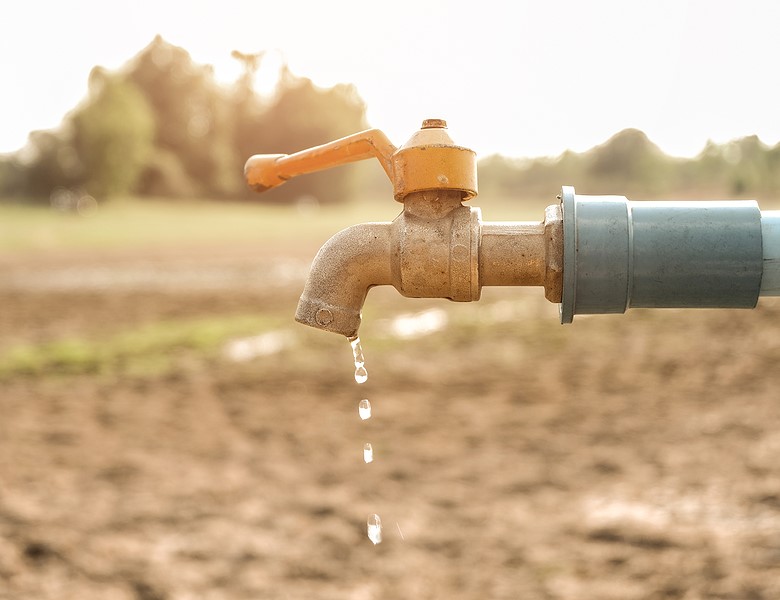News
Severe Water Stress Predicted For 7 England Regions By 2030
Despite the fact that the UK has a famously damp climate, it too will be affected by the water crisis, which is fast tightening its grip on countries all over the world, with water resources rapidly dwindling in the face of climate change, pollution, water mismanagement, population growth, urbanisation and more frequent extreme weather events.
It was initially thought that water shortages would be seen as early as 2040 in some parts of England, but now it seems that it may be even earlier than that, with new research revealing that seven regions around the country are expected to face severe water stress issues by the year 2030.
Carried out by Kingfisher (owner of B&Q and Screwfix), alongside economics firm Cebr, the study found that London, the East and West Midlands, some parts of the south-west, the east of England and the south-east are all now forecast to face serious problems in the relatively near future unless water resilience developments take place.
The south of England in particular is predicted to be the worst affected of them all, while at the other end of the scale, the north-west, the north-east and Yorkshire and the Humber will be less vulnerable to severe water stress.
Previously, the Environment Agency had issued a warning that by 2040 England runs the risk of running short of water and this new survey has suggested that, by then, the number of regions facing serious water stress concerns will climb from seven to 12, out of a total of 17.
At the moment, nowhere in England is classified as being water stressed, where demand for water exceeds local supplies… but thanks to climate change and population growth, as well as an increase in daily domestic water consumption, this looks set to change – and soon.
Domestic water use
The study also revealed that daily water usage in homes around England has been on the rise in recent years, with each person using 144 litres between 2021 and 2022, up from the 141 litres seen between 2017 and 2018, which is the equivalent to more than four large wheelie bins of water every week.
In a bid to address this looming gap between supply and demand, the government is now aiming to reduce individual water consumption to 122 litres per person per day come 2038, reducing this even more to 110 litres by 2050.
Thierry Garnier, CEO of Kingfisher, commented on these latest findings, saying: “Across Europe, we are experiencing more extreme weather, leading to increasing water scarcity in many regions.
“As the impact of climate change becomes more apparent, measures such as hose pipe bans are set to become much more common, with increasingly strong measures needed to reduce demand.
“We all have a role to play in conserving water. Making simple and affordable changes in our homes can have a huge impact, from installing water butts to collect rainwater for the garden to fitting tap aerators or low-flow shower heads. Governments can also help by encouraging the rollout of smart water meters and supporting the public to be more informed about water.”
Previous Kingfisher research has found that people actually significantly underestimate how much water they use each day, with 66 per cent saying they use less than 140 litres a day. On average, people believe they use just 57 litres of water each day.
However, despite this underestimation, 79 per cent of Brits say that reducing their water consumption is important to them, while 76 per cent say that saving water is more important now than it was ten years ago. Interestingly, 53 per cent said that they wished more information on saving water was available.
Tips from Kingfisher to help households reduce their water usage include reducing shower times, turning off the tap when brushing teeth, upgrading to a dual flush toilet, using low flow shower heads, fitting tap aerators, using a watering can and water butt in the garden, picking drought-resistant plants, and using mulch and bark to reduce water evaporation.
Business water use
For businesses, there are even more opportunities to become more water efficient, which will have the added benefit of boosting your company’s green credentials and ensuring that consumers look upon your brand in a favourable light.
There are three main approaches to reducing water use in a business. Firstly, water leak detection and repair is one of the quickest ways to reduce your water footprint and a full site survey will find leaks of any size so that repair work can be planned as required.
From there, you could consider having a water audit carried out, where your water usage is compared with what you’re being charged for. This will reveal any discrepancies that may have resulted in you being overcharged, allowing for various recommendations to be made to help reduce usage and lower your costs as a result.
And another option is water monitoring, where remote monitoring equipment is installed onsite that can track your water flow every hour for ten years. This can help you maximise efficiencies and identify leaks immediately, which could save you lots of water and potentially thousands of pounds into the bargain.
In fact, it’s possible that you could see savings of more than 30 per cent of your current water bill, so it’s certainly worth looking into from both a sustainable and financial perspective.
With water stress and scarcity seemingly becoming an increasingly urgent issue, it seems as though there’s no time quite like the present to start taking action to become a water steward to safeguard resources for future generations.
If you’d like to find out more, get in touch with the H2o Building Services team today to see how we can help you improve your business water management practices.
